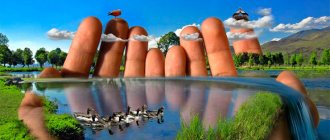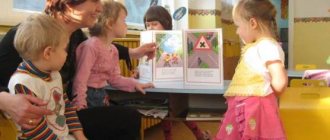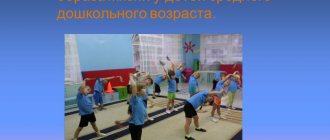Presentation on the topic “Forms and methods of environmental education of preschool children” presentation
Slide 1
FORMS AND METHODS OF ECOLOGICAL EDUCATION FOR PRESCHOOL CHILDREN
Slide 3
Observation Among the various methods of environmental education of preschoolers, an important place should be given to observation. Its essence lies in the sensory knowledge of natural objects, in their knowledge through various forms of perception - visual, auditory, tactile, gustatory, olfactory. The seasonal life of plants provides great opportunities for observation. The different conditions of trees and shrubs, the appearance and disappearance of herbaceous vegetation in the warm and cold seasons allow children, in the process of observation, to form ideas about the dependence of plant life on external conditions.
Slide 4
Requirements for conducting observations: 1. Any natural object should be as accessible as possible for perception. The child must see the object himself and everything that happens to it, hear the sounds emanating from it, be able to smell it, and hold it in his hands, if possible. 2. Temporal parameter of observation: examination and perception of any objects and natural phenomena should be short-lived. 3-10 minutes is the optimal time for intensive mental activity of children, for concentrating attention and independently obtaining and assimilating information. Children should begin and complete observation in a positive emotional state, without fatigue. 3. The third requirement is related to the structure of observations. Each of them has a beginning, a main part and an end. The beginning of observation solves a rather difficult task - to gather children and concentrate their attention. In the second, main part, the teacher asks questions and listens to the answers. The end of the observation should be emotional so that the children are in a good mood after it. Then next time they will want to observe themselves, without any special techniques
Slide 5
An excursion is another very interesting form of conducting environmental studies. An excursion is a complex event; it is planned, thought about, and prepared in advance. During the excursion, the mental development of children is influenced by various educational activities: observations of natural phenomena, explanations from adults, word games, guessing riddles.
Slide 6
Work. Interesting and varied work is carried out in the flower garden, vegetable garden, and plot. Children observe plants, practice labor skills (watering plants, loosening, collecting seeds and harvests, etc.). This work has a great influence on the development of hard work, independence and mutual assistance. In senior and preparatory school groups, it is possible to organize site duties in the spring and summer or assign groups of children to a garden bed or flower bed. The teacher conducts work and observations in a corner of nature with children every day. The form of organization of activities is different (depending on age). Children, starting from the younger group, are involved in certain work assignments.
Slide 7
Another form of environmental work in kindergarten is environmental holidays and leisure activities. Ecological holidays can be dedicated to the seasons, harvests, birds, etc.
Slide 8
Didactic games occupy a special place in introducing nature. By solving problems posed in a didactic game, the child learns to isolate individual characteristics of objects and phenomena, compare them, group them, and classify them according to certain general characteristics. Children learn to reason, draw conclusions, generalizations, while their attention, memory, and voluntary perception are trained. . Reading works of fiction about nature, looking at books of encyclopedic content
Slide 10
Environmental education is the education of morality, spirituality, and intelligence. The formation of the ecological culture of the population, the beginning of its formation falls on the first seven to eight years of a child’s life. It is in preschool age that learning the basics of environmental knowledge is most productive, since the child perceives nature very emotionally. The influence of nature on a child is enormous: it greets the baby with a sea of sounds and smells, secrets and riddles, makes him stop, take a closer look, and think. The beauty of the surrounding world gives rise to a feeling of attachment to the place where you were born and live, and, ultimately, love for the Fatherland.
MAGAZINE Preschooler.RF
Presentation of the environmental center in the senior groupMunicipal preschool educational institution "Kindergarten No. 10" Environmental center group No. 7
Educator: Osokina Ekaterina Andreevna Yaroslavl 2017
Relevance:
Preschool childhood is the initial stage of the formation of a person’s personality, his value orientation in the world around him. During this period, a positive attitude towards nature, towards the “man-made world” , towards oneself and towards the people around them is established. Children's activities cannot be complete outside the subject environment, otherwise the child's desire to learn new things will disappear, apathy and aggression will appear. A surrounding space that meets the requirements of the current and future creative development of each child, contributing to the timely identification and development of his abilities, will help to avoid them. An integral part of this space in a preschool educational institution is an ecological and developmental subject environment.
Goal: to form the foundations of environmental consciousness and environmental culture in preschool children
Tasks:
- mastering knowledge about the relationship between nature, society and man
- value orientations, motives, needs, habits of active environmental protection)
- ability to analyze environmental situations; assess the aesthetic state of the environment).
- fostering a humane attitude towards nature
- formation of the foundations of an ecological worldview
- expansion and deepening of preschoolers’ ideas about nature;
- development of cognitive skills in children (analyze what is observed in nature, draw conclusions about certain patterns and relationships, simply predict the consequences of human impact on natural objects)
The ecological environment of the group includes several mini-centers:
- Mini laboratory “Pochemuchka”
- Natural areas (layouts)
- Living area (plants)
- "Want to know everything".
- Didactic games
- Ah, this nature
1. Mini laboratory “Pochemuchka”
Special dishes:
- Cups
- Spoons
- Tubes
- Funnels
- Syringes
- Beakers
- Measuring spoons
- Measuring cups
- Pipettes
Natural materials: sand, earth, foam, sticks, shells, acorns, chestnuts, cones, chaga, seeds, acorns.
- Collection of industrial samples of fabrics and threads
- Collection of building materials
- Magnifiers, scales, leather samples, flashlight
- Collections of seeds and stones
- Card files with experiments
2. Natural areas (layouts)
- Layout "Life in the Forest"
- Kalinin family
- Model “Dry aquarium” Bragin family
- Layout “My Farm” Mazzhukhin Family
- Layout "World of Butterflies"
3. Living area (plants)
Houseplant passport
Sansevieria (pike tail), Chlorophytum, Spathiphyllum, Ficus Benjamina, Schlumbergera, Haworthia, Cordyline, Amaryllis
FlorariumThe Borovkov Family
4. "Want to know everything".
- Card indexes and fiction
- Lapbook “Invisible Air”
- Lapbook “World of Insects”
5. Educational games
6. Oh, this nature
- Nature calendar
- "Tree of Miracles"
- Didactic doll “Sonya” and card index of educational games
- Nature should not be madly loved, but consciously respected and appreciated.
| Next > |






